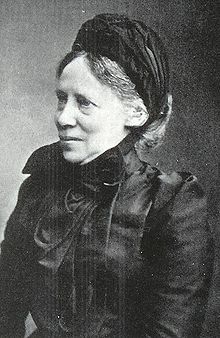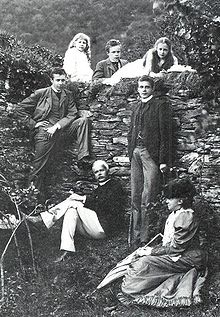Marie of Orange-Nassau (1841-1910)
Wilhelmina Frederika Anna Elisabeth Maria Fürstin zu Wied, Princess of the Netherlands , Princess of Orange-Nassau , called Marie , (born July 5, 1841 in Huize De Paauw, Wassenaar , † June 22, 1910 in Neuwied ), was the second daughter of Prince Frederick of the Netherlands and his wife Louise of Prussia . Her parents were cousins.
Life
Princess Marie suffered from hearing problems in her youth and, like her sister Luise, was not a beauty. Her parents were hoping to marry the British Crown Prince Edward VII. His mother, Queen Victoria , was initially in favor of the marriage. But when she saw Marie for the first time, she abandoned the plans. On the other hand, some contemporaries felt that she behaved in an engaging and regal manner at the same time.
On July 18, 1871, very late for the time, she married Prince Wilhelm zu Wied . The couple had six children, including Wilhelm , who was Prince of Albania for six months . Marie and Wilhelm lived in Germany on the Rhenish family seat of Schloss Neuwied . In 1870 Marie inherited her mother's summer residence, Schloss Schildau in the Hirschberger Valley in Lower Silesia , which she had extensively restored in 1906 and sold in 1908. After her father's death in 1881, she inherited the estate of Muskau , which she sold in 1883, as well as her birthplace, the Huize De Paauw in Wassenaar , which also included the former Von Wied pavilion in Scheveningen .
In her childhood there were numerous members of the House of Orange-Nassau; by the end of her life, however, the family had become very small and Marie saw opportunities for her family to take over the throne of the Netherlands. When the flags and coats of arms of the Dutch royal family were reorganized in 1907 , a section also dealt with Princess Marie. In 1909, however, the dynasty's legacy was secured with the birth of Princess Juliana . In 1910 Marie sold her Dutch property.
Marie was the last living member of the House of Orange alongside Queen Wilhelmina and Crown Princess Juliana, whose godmother she was.
children
Marie and Wilhelm had six children:
- Friedrich (1872–1945), sixth Prince of Wied, marries Pauline von Württemberg , daughter of Wilhelm II. Von Württemberg
- Alexander (1874–1877)
- Wilhelm (1876–1945), Prince of Albania
- Viktor (1877-1946)
- Luise (1880-1965)
- Elisabeth (1883–1938)
Streets
In memory of Marie, streets in several Dutch towns were named after him. For example, there are in Baarn , Amersfoort , Bussum and Wassenaar a princess Marielaan and in The Hague a princess Mariestraat .
medal
In the 19th century women were not yet accepted into the Dutch knightly orders. On March 19, 1905, Queen Wilhelmina awarded her second cousin, the only princess of the Netherlands at the time, the Grand Cross of the Order of Orange .
literature
- RWAM Cleverens, De Oranje-erfopvolging rond de eeuwwisseling . Uitgever Nobles 1997, ISBN 978-90-71103-10-0 .
- JA van Zelm van Eldik, Moed en deugd
Web links
| personal data | |
|---|---|
| SURNAME | Orange-Nassau, Marie von |
| ALTERNATIVE NAMES | Maria, Wilhelmina Frederika Anna Elisabeth |
| BRIEF DESCRIPTION | German-Dutch nobles |
| DATE OF BIRTH | July 5, 1841 |
| PLACE OF BIRTH | Huize De Paauw, Wassenaar |
| DATE OF DEATH | June 22, 1910 |
| Place of death | Neuwied |



